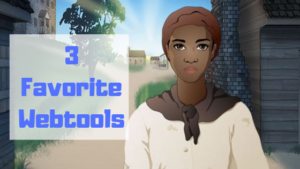 I subscribe to lots of technology-in-education forums (here’s a list of my trusted education advisors) and attend as many webinars as I can. In this way, I push outside of my bubble, away from my comfort zone, and along the way, discover some pretty amazing tools that I can’t wait to use in my classes.
I subscribe to lots of technology-in-education forums (here’s a list of my trusted education advisors) and attend as many webinars as I can. In this way, I push outside of my bubble, away from my comfort zone, and along the way, discover some pretty amazing tools that I can’t wait to use in my classes.
Here are three that I found just since school opened. I’d love to know your thoughts on these:
- Scholastic W.O.R.D.
- Peergrade
- Mission US
Scholastic W.O.R.D.
Scholastic’s W.O.R.D. (Words Open Reading Doors) is an independent K-5 learning resource that is committed to the principle that all kids should understand the words they use, how to use them to express themselves, and that doing so powers their lives. With this web-based program, kids learn to understand the high-utility word families that make up 90% of all texts. Since the number of words in the English language is far more for anyone except a bibliophile would be interested in, W.O.R.D. gathers them into manageable learning groups. Using a game-based format, students receive repeated exposure to high-utility words in multiple contexts and authentic ways that seem natural and age-appropriate. Learning objectives include homonyms, synonyms, expressions and phrases, picturable words, tenses, affixes, compound words, analogies, idioms, derivatives, and more — all broken down by grade level. They are introduced via themes to spark interest and keep students engaged. These include All About Me, What is a Hero, Blast from the Past, and more.
In W.O.R.D. (which by the way, is fee-based), students start with a placement test to determine their comprehension level and be sure they are challenged by assignments without being frustrated. They are introduced to words in their “zone of proximal development”. Teachers can monitor progress on the teacher dashboard, broken down by class and student. Robust reports are available to identify opportunities for enrichment, deeper dives, or additional support while providing feedback on which word skills students have begun and completed.
W.O.R.D. is pushed out to students in flexible twenty-minute sessions at a recommended pace of two-three per week. Lessons fit into most existing literacy programs. This is perfect for either a focused lesson plan or for students to play independently as part of a literacy center.
@scholastic
Peergrade

There are many truths about teaching but two stand out when it comes to assessing knowledge: 1) feedback is one of the greatest predictors of success in student work, and 2) teachers don’t have enough time to provide feedback on student work as thoroughly as they’d like. In response to this, peer feedback is growing in popularity as an approach that balances these two realities for the benefit of the student. A recognized leader in organizing peer reviews is the free online platform called Peergrade. It automates the process (which saves everyone time) and encourages critical thinking while facilitating the provision of quality feedback.
Peergrade makes it simple to facilitate peer feedback sessions for the benefit of both teachers and students. Teachers upload (called “create” in Peergrade) an assignment to the Peergrade website and add a rubric (which can be adapted from Peergrade’s library or built by the teacher). Students upload their responses to the assignment and it is automatically distributed to classmates, anonymously. The peer reviewer evaluates the work based on the rubric and provides feedback to their classmate. Completed feedback is delivered back to students. Everyone wins. The teacher has more time. Students gain valuable feedback on their work. Reviewers practice critical thinking as they provide thoughtful responses to reviewed work. The platform is intuitive, easy to use and understand, and requires little direction from the teacher. Teachers also get data-driven feedback to monitor student work, see who is falling behind, and what evaluation criteria (from the rubrics) is not working.
Peergrade is not designed for grading, rather as one step in the write-edit-rewrite-submit process. While this is best suited for grades 6-12, you decide if it fits your student group.
Mission US
Gamifying education is an acknowledged success in its ability to electrify learning and make a more effective learning tool for today’s students. But, teachers want more than yesterday’s simple games, originally used as a replacement for worksheets. The most popular games now involve critical thinking, problem solving, and decision making, with few rote exercises or drills.
Enter the free Mission US, a suite of games aimed at grades 5-9 that interactively address the critical events in United States history. These are taught in a choose-your-own-adventure approach that encourages students to dig deeply into history, evaluating cause and effect, and making choices that they can support with evidence. Creators of these games wanted to help students relate to the events and people by being part of the action.
Game topics include:
- Crown or Colony
- Flight to Freedom
- A Cheyenne Odyssey
- City of Immigrants
- Up from the Devastation of the Dust Bowl
- Japanese incarceration (coming)
- Civil Rights Movement (coming)
Mission US gameplay is web-based, on PCs, Macs, and Chromebooks, and even some iPads. It works best on Chrome, not so well on IE (but does work on Edge). Each mission includes an Educator Guide with lesson plans, questions, and suggestions to support struggling students as well as ideas for how to easily integrate the games into the curriculum and class time. Some of the most popular integrations are how to research, critical thinking, consequences of choice, perspective-taking, literacy, cause and effect, and writing skills (for those who use the writing prompts, reflections, and review questions).
Games take a couple of class sessions but this depends upon how many of the available resources are included with the gameplay. In my experience, everyone loved these lessons.
@mission_us
***
If you’re like me, you hear about dozens of webtools and apps that sound great but don’t get past the first effort. What are new favorites you discovered this school year that have worked well with students?
More favorite webtools:
Gamechanger: Type to Learn is Now in the Cloud!
Adobe Spark — All-purpose Desktop Publishing Tool for the Classroom
Jacqui Murray has been teaching K-18 technology for 30 years. She is the editor/author of over a hundred tech ed resources including a K-12 technology curriculum, K-8 keyboard curriculum, K-8 Digital Citizenship curriculum. She is an adjunct professor in tech ed, Master Teacher, webmaster for four blogs, an Amazon Vine Voice, CSTA presentation reviewer, freelance journalist on tech ed topics, contributor to NEA Today, and author of the tech thrillers, To Hunt a Sub and Twenty-four Days. You can find her resources at Structured Learning.




































